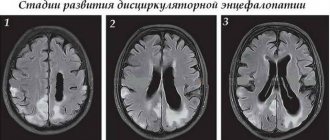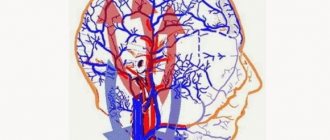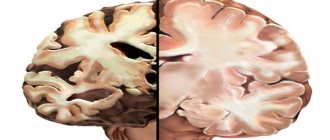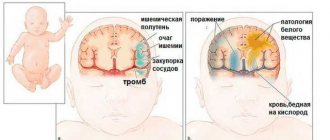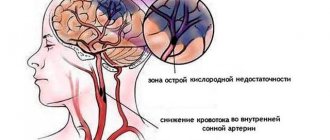Dyscirculatory encephalopathy is a disease in which chronic progressive damage to brain tissue occurs due to circulatory disorders. It is noteworthy that this pathological condition has become much younger over the past 30 years. If previously grade 2 dyscirculatory encephalopathy was found exclusively in older people, today it is also diagnosed in 40-year-olds. Ignoring signs of a problem leads to a gradual decrease in the patient’s performance, a deterioration in his quality of life, and the development of disability or stroke. Early diagnosis of a disease with a characteristic clinical picture can reduce the risks of negative consequences and improve the prognosis.
You will learn more information about the disease from this article.
Main causes of dyscirculatory encephalopathy
A decrease in the functionality of brain vessels leads to disruption of blood flow in the tissues. Certain areas begin to experience a deficiency of oxygen and nutrients, which is why cell colonies first die, and then large areas of the brain matter. At first, the functions of these areas are taken over by neighboring zones, but in the absence of treatment this connection is lost.
The causes of the disease depend on its form:
- atherosclerotic - harmful protein and lipid compounds accumulate on the walls of blood vessels, narrowing their lumen. Hypoxia of the brain develops, the organ ceases to perform its functions to the required extent. Pathology is often a consequence of poor nutrition, leading to increased cholesterol levels;
You will learn about atherosclerosis and its impact on the development of various pathologies here.
- venous - the result of compression of the veins through which blood, along with metabolic products, is removed from the brain. The tissues are literally poisoned by toxins, and inflammatory processes develop. The risk of this form appearing in a person increases if there is a history of heart or pulmonary failure, tumors, or surges in blood pressure;
- hypertensive – characterized by acute development against the background of a sharp increase in blood pressure. This phenomenon leads to spasm of blood vessels, which try to maintain integrity and not burst. Over time, the channels begin to thicken inward, which narrows their lumen. The risk group includes patients with hypertension, glomerulonephritis, liver failure, and Cushing's disease.
You will learn about the symptoms of hypertension and possible complications of the pathology here.
Smoking and alcohol are factors in the development of dyscirculatory encephalopathy
The disease can also be a consequence of VSD, smoking and alcohol abuse, blood disorders, toxin poisoning and osteochondrosis of the cervical spine. A separate group includes DEP of mixed origin, in which several factors are to blame for the development of the pathology. Most often there is a combination of atherosclerotic and hypertensive forms. This type of disease progresses most quickly and is typical for older people.
Treatment approach
The goal of therapeutic measures is to treat the underlying pathology, eliminate lesions and restore brain function, protecting it from oxygen starvation.
Treatment of grade 3 dyscirculatory encephalopathy is complex.
To eliminate the pathology and restore the condition of the brain cells, you need to strictly follow all the recommendations.
A diet with limited salt and fat is prescribed. The use of vitamins is mandatory.
It is important to engage in psychotherapy.
The patient will recover more easily if he is occupied with certain tasks that he can perform. This approach will help him realize that there is a chance for recovery.
Drug treatment
Several drugs are prescribed at once to ensure normal blood flow, restore nerve cells and eliminate the cause.
The following drugs are used:
- Lisinopril is a drug to lower blood pressure if hypertension has led to the development of DEP.
- Acetylsalicylic acid (aspirin) – thins the blood, prevents platelets from sticking together and blocking blood vessels.
- Curantil - helps to increase the lumen of capillaries, strengthens their walls.
- Nimodipine - blocks the supply of calcium to the muscles, which leads to their relaxation and improved blood flow. As a result, movements improve and the ability to think sensibly is restored.
- Atenolol - removes excess fluid from the body, normalizes heart function, increases blood flow, reduces heart rate and blood pressure.
- Vasobral - protects brain cells from oxygen starvation, prevents the formation of blood clots, improves metabolic processes in the subcortex, and restores functions.
- Ginseng tincture is a natural remedy. It helps increase productivity, improves brain function, cardiovascular system, reduces the amount of cholesterol in the blood, and fights increased fatigue. However, the use of ginseng tincture for hypertension is contraindicated.
Physiotherapeutic methods are also used in the treatment of grade 3 DEP: electric sleep, massage, galvanotherapy, baths, laser and UHF therapy.
Surgery
This method is used if drug treatment does not give the desired results. Surgery is performed on the great vessels.
Three stages of the disease
Stages (degrees) of dyscirculatory encephalopathy:
- the first stage – organic changes in the brain are minor, but characteristic symptoms are already appearing. Signs of disorders can be confused with the clinical picture of a number of other lesions of the central nervous system. Most often these are fatigue, decreased memory and attention, tinnitus and headache, deterioration in sleep quality, causeless irritability and bad mood;
You will read more about the first stage of the disease in this article.
- second stage – the pathology progresses, so its signs are more vivid, and a decrease in brain functionality is obvious. At the same time, the patient is still able to take care of himself independently and does not need constant supervision from the outside. The first and second degrees of dyscirculatory encephalopathy are sometimes not differentiated. Officially, the diagnosis is made when signs characteristic of DEP persist for 6 months;
- the third stage is a period of irreversible and profound organic changes. The patient is not able to take care of himself, his behavior is often inadequate, dangerous for himself and others. The patient is assigned a disability; therapy does not bring significant relief, but only prolongs life.
How long you can live after diagnosis depends on the stage of the disease, the individual characteristics of the body and the quality of care provided to the patient. It is noteworthy that at a young age, dyscirculatory encephalopathy develops acutely and rapidly, but it responds well to treatment. In patients over 60 years of age, disability is diagnosed in almost 80% of cases.
Symptoms of dyscirculatory encephalopathy of the second degree
The sooner treatment for stage 2 DEP begins, the higher the chances of preventing irreversible consequences and complications of the pathology.
Therefore, it is important to understand what signs may indicate the onset of organic changes in the brain. Depending on the form of the disease, the classic clinical picture is supplemented by specific manifestations. In hypertensive DEP, persistent arterial hypertension is observed. If the cause of the disease is atherosclerosis of the cerebral vessels, then initially the patient complains of tinnitus, dizziness, fatigue and fatigue. List of classic symptoms of the second stage of dyscirculatory encephalopathy:
- constant and obsessive headaches;
- nausea and vomiting for no apparent reason;
- dizziness, staggering when walking;
- deterioration in sleep quality;
- vasodilation during fundus examination;
- change in the patient’s facial expression due to pallor and deterioration in the functioning of the facial muscles;
- problems with coordination of movements that do not allow performing actions that require the use of fine motor skills of the hands;
- hearing and memory impairment, speech problems, minor twitching of the limbs;
- tearfulness and moodiness, mood swings, irritability and aggressiveness, feelings of fear for no apparent reason.
The symptoms that characterize grade 2 dyscirculatory encephalopathy can appear constantly or at the end of the day. Often, patients experience not individual symptoms, but entire syndromes.
Within their framework, specific manifestations turn into functional failure. Some people suffer the most from their thinking, while others experience serious disturbances in sleep or motor activity.
Disability at the second stage
The third disability group is given to those patients with dyscirculatory encephalopathy who are able to perform everyday and professional activities, but this is difficult for them. At the same time, living with the disease is possible without constant monitoring from loved ones or specialists. In general, each specific case requires an individual approach and consideration.
The second group is given to people whose condition is not limited to cephalgic syndrome (headache, tinnitus, nausea and vomiting). Due to deterioration of memory, attention, and tremors of the limbs, they are unable to maintain their ability to work. Impaired functioning is obvious, but it does not necessarily mean that the patient is completely unable to care for himself.
Diagnosis of pathology
Making a preliminary diagnosis begins with collecting complete information about the situation. The clinical picture of second-degree DEP is often similar to other forms of brain damage. In order to identify real pathology, neurologists conduct tests that identify problems with coordination and cognitive impairment. Blood pressure indicators are assessed and cholesterol levels in the blood are determined.
To confirm the diagnosis of grade 2 dyscirculatory encephalopathy, the following studies are carried out:
- CT or MRI – identifying the area of tissue damage;
- Doppler ultrasound and rheoencephalography – assessment of the condition of cerebral vessels;
- neuropsychological study - identifying damage to the higher functions of the nervous system;
- identifying neurological manifestations of the disease by checking reflexes.
You can learn more about diagnostics using rheoencephalography here.
A comprehensive diagnosis of stage 2 DEP allows not only to confirm the presence of problems, but also to determine the degree of their severity. Based on the research results, therapy is prescribed aimed at overall improvement of the condition of the blood vessels in the brain, combating individual symptoms and causes of decreased functionality of the blood channels.
Prevention of occurrence
To protect yourself from the risk of dyscirculatory encephalopathy of any degree, you should adhere to some preventive measures:
- Treat any systemic diseases in a timely manner, as well as undergo regular examinations if you have chronic diseases.
- Adhere to the principles of healthy eating. Eliminate fatty, smoked and salty foods from the diet, increase the proportion of greens, fruits, vegetables and seafood.
- Lead a healthy lifestyle. Give up bad habits, regularly walk in the fresh air and play sports.
- Reduce the number of traumatic situations, learn to deal with stress.
The above recommendations are easy to follow if desired. They will help not only prevent the development of a complex disease, but will also help improve the quality of life.
A disease such as grade 2 dyscirculatory encephalopathy requires timely detection and competent treatment. You can lead a normal life with this disease. It is only important to adhere to all the instructions of the attending physician and undergo regular preventive examinations to eliminate the risk of transition to a more severe stage.
Treatment method for dyscirculatory encephalopathy 2nd degree
Therapy must be comprehensive, the list of manipulations is selected individually for each patient. With grade 2 DEP, patients may forget about prescriptions or have problems implementing them, so they need help from loved ones. If you strictly follow the recommendations, you can expect signs of improvement to appear 1-3 months after the start of treatment.
Non-drug therapy
Physiotherapy has a good effect in the treatment of dyscirculatory encephalopathy.
Depending on the causes of vascular damage and the clinical picture, patients are prescribed electrosleep, galvanic currents, UHF and laser therapy. Sometimes non-traditional approaches are used, such as acupuncture. The following points contribute to improving the condition of patients:
- prevention of stressful situations;
- frequent and prolonged stay in the fresh air;
- avoidance of excessive physical activity and heavy lifting;
- participation in a regimen of simple physical exercises agreed with the doctor;
- performing therapeutic exercises;
- quitting smoking and drinking alcohol;
- weight correction if it exceeds the norm.
Following simple recommendations improves the prognosis and alleviates the patient's condition. If necessary, the patient is additionally assigned sessions with a psychologist or psychotherapist. Art therapy and occupational therapy have a good effect.
Drug treatment
Drugs aimed at treating grade 2 dyscirculatory encephalopathy are selected by the doctor depending on the form of the disease and its symptoms. In case of hypertensive DEP, the use of medications that normalize blood pressure is necessary. Against the background of vascular atherosclerosis, therapy is carried out aimed at destroying cholesterol plaques and cleaning blood channels. Additionally, vitamins, nootropics, sedatives and antidepressants may be prescribed.
Folk remedies
Taking infusions and decoctions based on medicinal herbs successfully combats the symptoms and causes of the disease. The maximum effect is achieved by drinks based on propolis, clover, hawthorn, onion, valerian, chamomile and mint, hop cones and rose hips. In case of DEP, treatment with folk remedies cannot be the only option for influencing the disease. The approach should complement the main therapy and is recommended to be agreed with your doctor.
Diet
Compliance with the principles of proper nutrition against the background of stage 2 DEP gives a therapeutic effect no less pronounced than taking medications. The patient will have to give up foods that provoke a decrease in the functionality of blood vessels and cause nervous strain. This list includes fatty, fried and spicy foods, alcoholic and energy drinks, coffee and soda, semi-finished products and dishes with preservatives, dyes, and chemical additives. When compiling a diet, it is necessary to focus on fresh fruits and vegetables, onions and garlic, fish and white meat, light dishes that do not overload the body.
Discirculatory encephalopathy of the 2nd degree is difficult, but realistic to fight. If problems are identified early and treatment is started, the prognosis is favorable. Compliance with the doctor’s recommendations can give the patient several years or even decades of life at a high level. The main thing is to regularly visit a neurologist in order to assess the patient’s condition and make adjustments to the treatment plan.
Treatment
Therapy is selected strictly individually, and in treatment doctors use an integrated approach, combining medicinal and non-medicinal methods:
Medicines . To treat each type of pathology, the doctor selects his own drug. These are medications aimed at stabilizing blood pressure levels, eliminating cholesterol deposits, sedatives and tranquilizers. Taking vitamins is also indicated.
Non-drug treatment includes physiotherapeutic procedures, avoiding stressful situations, staying in the fresh air, exercise therapy, fighting obesity and giving up bad habits, consultations with a psychotherapist.
Dietary food . Dishes that negatively affect the condition of blood vessels are excluded from the diet. These are fried, smoked, salty foods, semi-finished products, chips and snacks, sweet sodas. Instead, the diet is enriched with fish, poultry, vegetables, fruits and herbs.
An integrated approach will contribute to positive dynamics in DEP of degree 2, will help the patient feel good and increase the length and quality of life.
